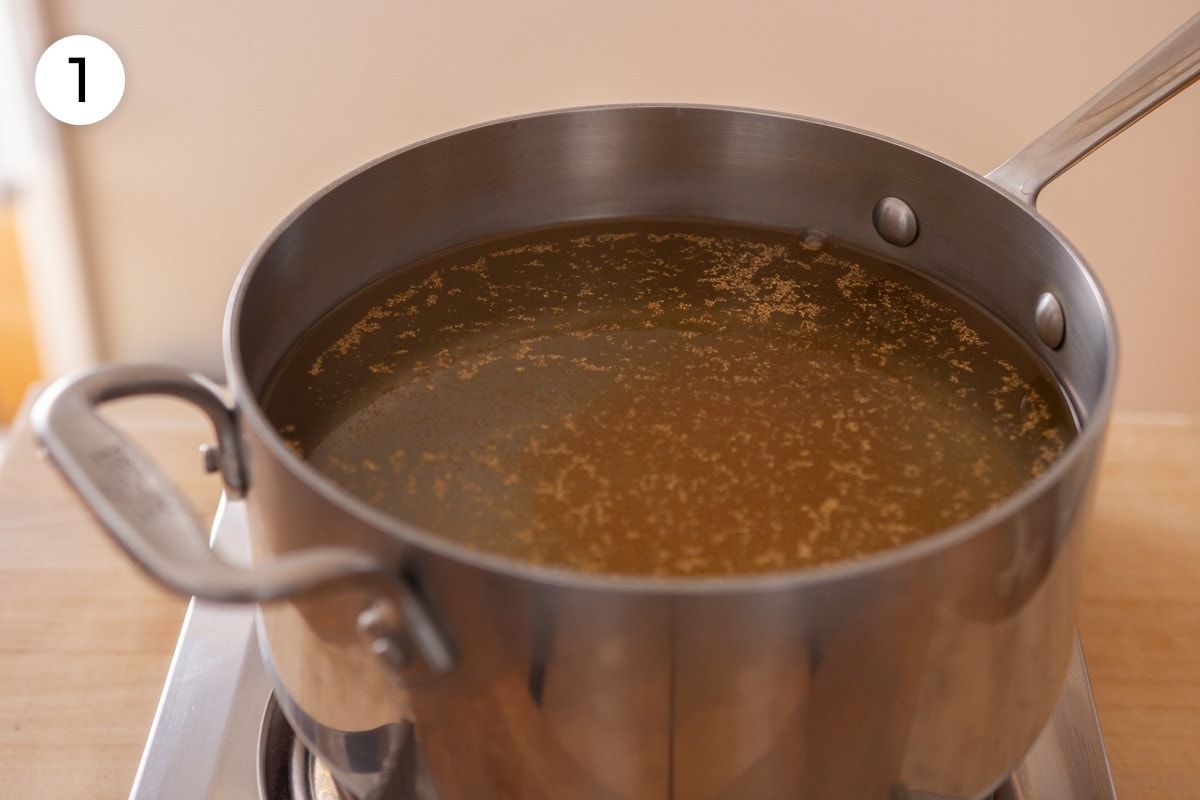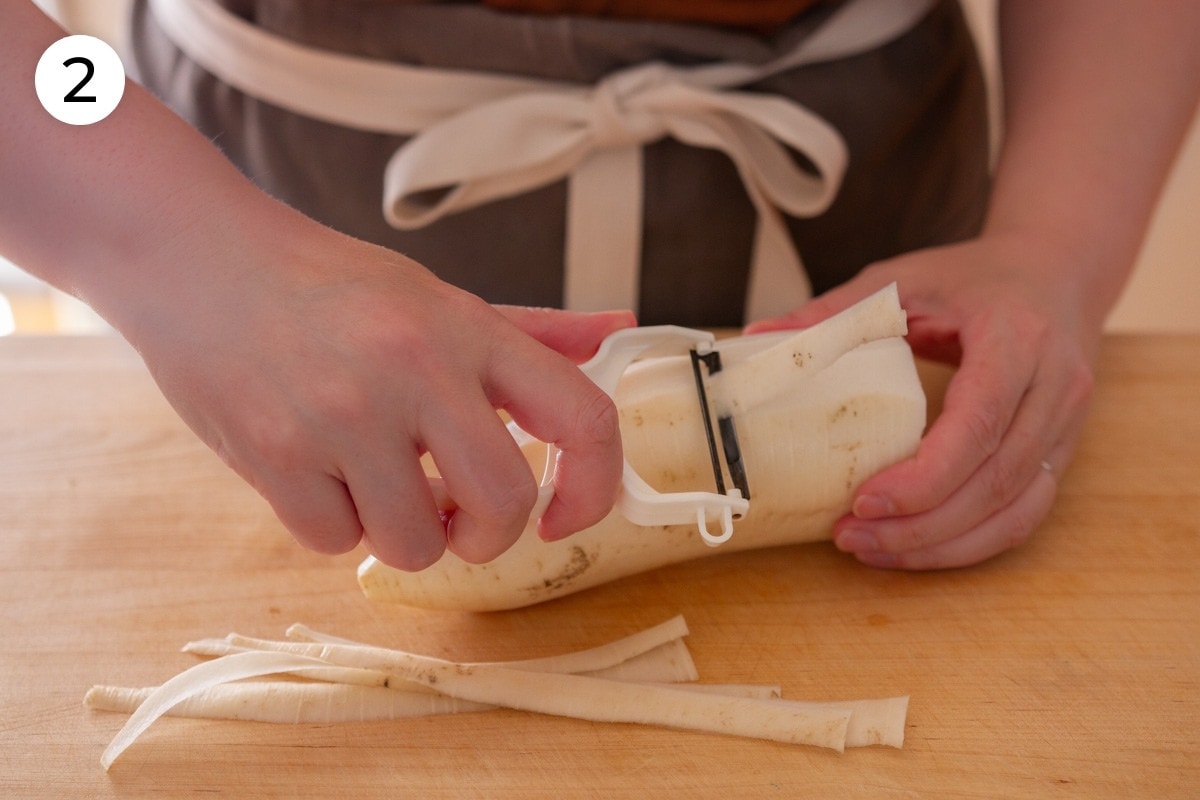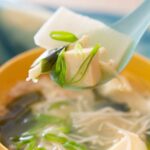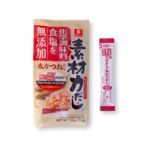Sip on this comforting and nourishing soup in just 20 minutes. How is this miso soup gluten-free, you ask? With a simple swap, this traditional miso paste and dashi-based soup is ready for your gluten-free guests to enjoy!
I'll guide you through making basic dashi broth for miso soup in addition to showing you exactly how to cut optional ingredients to make miso soup with daikon and enoki mushrooms. You'll be able to add this to your go-to list of quick and easy recipes!

jump to:
✨ why you'll love this recipe
This miso soup is so easy to make - I think it'll wind up surprising you. Since you don't have to make the dashi stock from scratch, this soup can be ready within 15-20 minutes tops!
Side note: I've made dashi from scratch for miso soup using Shizuo Tsuji's recipe in Japanese Cooking: A Simple Art (affiliate link) and the flavor of this easier version tastes just as good!
serving suggestions
Japanese miso soup is traditionally enjoyed with rice, but this recipe also pairs well with juicy dumplings or kimchi fried rice.
It really goes well with a variety of dishes, including this Din Tai Fung cucumber salad.
Check out more cozy east asian soups including my 5-ingredient bitter melon soup. And if you're a huge daikon fan like I am, try this delicious purple daikon recipe.
gluten-free and other variations
You may be wondering what makes this miso soup gluten-free. Well, despite typically using more traditional white miso paste, I always have a gluten-free miso paste around in case I need to serve guests with dietary restrictions (I'm a registered dietitian nutritionist after all).
I thought this would be a great opportunity to share a gluten-free miso! (If you'd rather use a different kind of miso, there are so many different types that vary on the scales of light to dark, and sweet to salty; check out some of them below.)
In this recipe, I also added daikon and mushrooms, which means this version could also be called miso veg. soup (野菜のお味噌汁) or miso soup with mushroom. This is one way you can customize your recipe - use whatever vegetable sounds good to you.
Another reason I think you'll love this recipe is because the nutrition in miso soup is well-rounded. There's a good balance of protein, carbohydrates, and fiber. Plus, the soup broth can help to keep you hydrated!
✨ the allure of miso soup
Miso soup (or miso-shiru 味噌汁 in Japanese, 味噌湯 in Chinese, and tāu-chiùⁿ-thng in Taiwanese) is a savory Japanese soup made of miso paste and dashi (stock), but it doesn't stop there! There are so many different variations of miso soup that I grew up loving.
There are so many Japanese influences in Taiwanese cuisine, including (but not limited to) soups that highlight fresh and seasonal ingredients. These dishes are commonly served with all meals at home, including breakfast, and miso is such a quick and easy version of this tradition.
It's quick, easy, and pairs wonderfully with a bowl of white rice. The general makeup of miso soup is…
- Stock
- Miso paste
- Optional toppings
"It is impossible for miso soup to be boring. It can be based on any type of miso, from salty to sweet, and it is always served with supplementary ingredients and seasonings. In the course of the four seasons, relying on easily available produce and nonseasonal staples, one can make a different miso soup nearly every day without repetition." - Japanese Cooking: A Simple Art (affiliate link)
Once you have the base stock made, you can add pretty much any seasonal vegetables to it based on what you like. I often made miso soup for breakfast as a kid!
📋 key ingredients
Below I'll share the basic ingredients of this recipe, and then I'll break it down even further to give you more miso and dashi broth options.

miso paste - see options below
dashi granules - see options below.
You can find dashi granules in Japanese grocery stores as well as Taiwanese stores like 99 Ranch Market, Korean markets like H Mart, or your local Asian grocery store. It's usually located in the pantry items aisles, sometimes by soup stocks and sauces. You can also find it online at Weee! (affiliate link) or Amazon
silken tofu - any tofu labeled as "silken" or even "soft" will work too.
enoki mushroom - optional but one of my favorite additions to this recipe!
You can also use thinly sliced king trumpet mushrooms or shimeji (beech) mushrooms as a substitute.
daikon radish - optional but also one of my favorite vegetables to include in miso soup.
wakame (affiliate link) - this dried seaweed can be found in Japanese, Taiwanese, and Korean grocery stores, or online.
scallions - added for a pop of green and flavor. I don't always include this in my miso soup, but enjoy it every once in a while.
See the recipe card for quantities.
miso options
The type of miso you use can also be customized to your taste because there are so many different kinds. Here are some of the most commonly found types in the US (note the gluten-free version):
- shiro-miso (white miso) (affiliate link) - It's sweet and smooth (fine-textured). Works great in soups and sauces/dressings to use with vegetables or salads.
- sendai miso (red miso) (affiliate link)- Full of flavor, made with a combination of rice, barley, and beans. It also works great for miso soup.
- awase miso (affiliate link) - a combination of white and red miso paste
There's also a yellow miso called shinshū-miso (affiliate link) that's saltier than white miso with a hint of tartness. It's good for general cooking needs and is probably the most commonly used type in the US. I would recommend red, white, or awase for this recipe though.

For this gluten-free miso soup recipe, look for miso paste labeled as gluten-free (affiliate link). This is a brand more commonly found in Japanese grocery stores in the US.
dashi options
There are quite a few options for dashi granules, but these are my favorites. I almost always have them stocked in my pantry since they're super easy to use.

- konbu stock (affiliate link) - use this for vegan or vegetarian miso soup since it's kelp-based soup stock.
- bonito dashi granules (affiliate link) - this is fish-based and my go-to one!
- hondashi (affiliate link) - this brand of dried dashi stock includes even more flavor boosters like added MSG. I say 'added' since, like many other foods (including mushrooms and tomatoes), other dashi granules have naturally occurring MSG.
📖 substitutions
As you can see above, I've provided a few different miso and dashi brand substitutions if you can't find one or the other. However, the miso and dashi themselves can't be substituted with completely different ingredients since they're the base of this recipe.
One ingredient that can be substituted is our miso soup mushroom - enoki! Go for a milder flavored mushroom like these:
- Use one large king trumpet mushroom (about 3 ounces or 85 grams) and thinly slice it on a diagonal
- Try a 3.5-ounce (100-gram) package of beech (shimeji) mushrooms with the ends cut off and separated into smaller chunks by hand.
📖 variations
- vegetarian - make your miso soup vegetarian or vegan by using konbu (kelp-based) dashi granules (affiliate link) in place of bonito dashi.
- fancy with added protein - add chunks of seared salmon fillet to each bowl of miso soup.
- seasonal - add your choice of seasonal vegetables. You can get creative here! I've had miso soup with carrots, a variety of mushrooms, cabbage, okra, garlic scapes, and more.
🔪 instructions
I'm going to go through each step in detail below, including step-by-step photos of how to prepare your silken tofu, daikon radish (a secret restaurant way of cutting it!), and enoki mushrooms. In a hurry? You can jump straight to the printable recipe.
cooking miso soup
Let's start with the soup base.

Place 8 cups of water and 2 tablespoons of dashi granules in a medium (3-quart or 3-liter) saucepan and bring to a simmer (just before boiling), then lower the heat to medium.

Place the miso paste in a small fine-mesh strainer. Lower the strainer into the pot until the miso paste is submerged in the water. Stir the miso with chopsticks or a small whisk until it is fully dissolved.
Alternatively, you can add the miso paste directly into the simmering water and whisk until dissolved - it's a lot faster and easier with a strainer though!
tip: Prepare the silken tofu, scallion, optional daikon radish and enoki mushrooms (if using) while the soup base simmers. See the step-by-step photos below on how to prepare each ingredient.

Turn up the heat to medium and immediately add in the cut enoki mushrooms (optional), sliced daikon radish (optional), silken tofu, and ¼ cup wakame (about 20 grams).

Simmer until the daikon just starts to turn translucent (about 10 minutes). Ladle into individual soup bowls and top with sliced scallions.
how to cut tofu and scallions

Prepare 1 (14-ounce) package of silken tofu by draining it, removing it from its container, and cutting it into cubes.

Cut the silken tofu into 1-inch (50-millimeter) cubes. I like to slice it in half first as shown above before cutting it into bite-sized cubes.

Cut the end off of 1 washed scallion.

Thinly slice scallion on a bias (at an angle).
how to cut a daikon radish
This ingredient is optional, but one of my favorites to add to this recipe. Here, I'll show you a special way to cut daikon that's not widely shared.

Cut off a 6-inch piece (about 150 millimeters) of daikon.

This way you're only peeling the part of the daikon that you'll use right away. The other half will stay fresh longer stored in the refrigerator.

Cut the daikon into 2-inch long pieces (about 50 millimeters).

Place each disk flat side down and slice the daikon from the top down with the grain into ¼-inch (6-millimeter) thick slices.
pro tip: When using daikon in soups, cut slices with the grain rather than against the grain (as shown in the step-by-step photos above). This will give each slice a satisfying toothsome bite even after being fully cooked. That way you avoid soggy, too-soft, vegetables even when reheating a bowl of miso soup.
how to cut enoki mushrooms
Enoki mushrooms are another favorite but optional ingredient. I love it in miso soup! If you can't find enoki, shimeji (beech mushrooms) or thinly sliced king trumpet mushrooms would work best as substitutes.

Cut the ends off of 1 package of enoki mushrooms (about 7 ounces or 200 grams). I like to cut the ends off while they're still in the package so the roots don't get everywhere.

Cut them in half lengthwise.

Separate the ends into smaller chunks.

Using clean hands, pull small segments of the enoki ends apart so that they're in bite-sized chunks.
🍲 equipment
Note: Some of the links below are affiliate links, which means we do make a small profit from your purchases (your price is not affected by this commission). We are a participant in the Amazon Services LLC Associates Program, an affiliate advertising program designed to provide a means for us to earn fees by linking to Amazon.com and affiliated sites. If you click on an affiliate link, you consent to a cookie being placed on your browser for purposes of tracking commissions.
- Medium saucepan (3-quart, about 3-liter)
- Small fine mesh strainer
- Ladle
- Cutting Board
- Chef's knife
❄️ storage
How long does miso soup last? Miso soup can be stored in covered containers in the refrigerator for up to 4 days. I often prepare a large batch to enjoy for breakfast during the week.
Reheat it in the microwave, covered, for 30 seconds - 1 minute, or in a small saucepan on the stove just until it starts to simmer (about 5 minutes).
freezing
The miso soup base (water, dashi, miso, and wakame) can be frozen in pint or quart-sized freezer-friendly containers. You can also freeze it in Souper cubes (affiliate link) for different portion sizes. Just make sure to leave room at the top since the contents will expand when frozen.
Tofu, daikon radish, enoki mushrooms: These ingredients don't stand up well to freezing since the texture will change. You can add these to the reheated soup base.
Although wakame can be frozen with the soup, I tend to add it to reheated soup since dried wakame has a long shelf life in the pantry.
Reheating frozen soup: Reheat directly from the freezer in a small saucepan on the stove just until it starts to simmer, then add in freshly cut silken tofu, wakame, and optional ingredients like daikon and enoki mushrooms.
Simmer until the daikon just starts to turn translucent (about 10 minutes).
💭 top expert tip
Keep the stove on medium heat or lower when simmering miso soup. You never want it to boil since it will change the flavor in a subtle way. If you find the pot of soup coming to a boil, immediately turn off the stove and remove the pot from the heat.
💭 faq
Miso soup is not typically gluten-free since it depends on the type of miso paste used. There are gluten-free versions of miso that you can buy. Just look for the gluten-free label and you can use it to make your miso soup gluten-free.
Miso soup is not a clear soup since one of its main ingredients is miso (fermented bean paste), which gives it a slightly cloudy appearance. It's in the category of "thick" soups in Japanese cuisine.
Clear soup is called suimono (吸い物), or more commonly as osuimono (meaning "something to sip"), and is usually served in formal dining settings or during special occasions. Osuimono follows specific rules to highlight the color, aroma, and subtle flavors of three ingredients. The stock is made clear and is the most important component of the dish.
Sumashijiru (澄まし汁) is another type of Japanese clear soup that is enjoyed more casually in home cooking. Both highlight seasonal ingredients and are meant to complement a meal. Since the dashi broth is important in both, it's best to make dashi broth from scratch for clear soups rather than use dried dashi granules.
The base of miso soup is savory-tasting with a satisfying umami flavor. If you include additional ingredients it will alter the taste slightly.
Miso soup can be vegan and vegetarian if you use the vegetarian form of dashi (known as konbu dashi) so that fish is not included in your soup base. Just like fish-based dashi granules, konbu dashi granules or dry konbu dashi can also be found in Japanese grocery stores or online.

🥒 delicious soup pairings
Not sure what to eat with miso soup? Here are some simple and flavorful dishes to try:
👨🍳 COOKING WITH KIDS
What can kid chefs help with?
- breaking up the enoki mushrooms
- measuring out dashi granules and wakame
- stirring the pot of miso soup with supervision
Let me know if you have any questions in the comments below.
Happy cooking! ~ Cin
Want to get recipe updates, pro cooking tips, and nutrition info on East Asian ingredients straight to your inbox? Sign up here for a free PDF with cozy soup recipes.
Please give this recipe a star rating ⭐️⭐️⭐️⭐️⭐️ if you make it. I would love to hear from you! If you have any questions at all, let me know in the comments below.
Want to Save This Recipe?
I'll send it to your inbox - just enter your email below. Plus, you'll get new recipes and pro cooking tips from me!
By submitting to this form, I consent to receive emails. Don't worry, you can unsubscribe anytime.
miso soup (gluten-free) 味噌汁
ingredients
- 8 cups water
- 2 tablespoons bonito dashi granules, (substitute: konbu dashi for vegan option)
- 6 tablespoons miso paste, white, awase, or red, labeled gluten-free
- 1 (14-ounce) package silken tofu, drained, and cut into 1-inch (50-millimeter) cubes
- 1 scallion, ends removed and thinly sliced
- 6 inch piece of daikon radish, (about 150 millimeters), optional, peeled and cut into ¼-inch (6-millimeter) thick slices
- 1 (7-ounce) package enoki mushrooms, (about 200 grams), optional, ends cut off and cut in half lengthwise (separate the ends into smaller chunks by hand)
- ¼ cup wakame, dried seaweed
*The Instacart button above is an affiliate link, which means we do make a small profit from your purchases (your price is not affected by this commission).
instructions
- Place 8 cups water and 2 tablespoons bonito dashi granules in a medium (3-quart or 3-liter) saucepan and bring to a simmer (just before boiling), then lower the heat to medium.
- Place 6 tablespoons miso paste in a small strainer. Lower the strainer into the pot of simmering broth until the miso paste is submerged. Stir the miso with chopsticks or a small whisk until it is fully dissolved. Alternatively, you can add the miso paste directly into the simmering water and whisk until dissolved.
- Prepare the silken tofu, scallion, optional daikon radish and enoki mushrooms (if using) while you wait for the stock to simmer.
- Turn up the heat to medium and immediately add in the cut enoki mushrooms (optional), sliced daikon radish (optional), silken tofu, and ¼ cup wakame. Cook until the daikon just starts to turn translucent (about 10 minutes).
- Ladle into individual soup bowls and top with sliced scallions.
equipment and highlighted ingredients
notes
🌡️ food safety
- Cook to a minimum temperature of 165 °F (74 °C)
- Wash hands before handling ingredients, especially if they won't be cooked like the scallions
- Don't leave the soup sitting out at room temperature for extended periods
- Never leave cooking food unattended
- Always have good ventilation when using a gas stove




















Christina says
This recipe is delicious! I’ll always remember how it hit the spot when I was recovering from giving birth to our baby and my partner whipped this up. I’m so excited to make it with baby when he’s ready for food!
Ronnie says
I never knew it was this easy to make delicious miso soup at home. Tastes just like at the restaurant. 10/10. Will definitely keep it in the rotation.